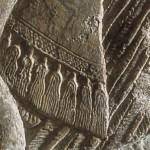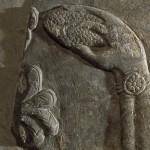Bird-Headed Deity
This stone carving comes from the palace of King Ashurnasirpal II, who ruled over the kingdom of Assyria in today’s Iraq. The creation of a sculptured palace generally happened only once during a king’s reign, if at all. The king took close interest in the palace and had some indirect role in choosing the subjects of the decorations. However, the general design was placed in the hands of a committee of senior officials. Within this committee, at least one official was experienced in magic, and he made sure that the magical figures on the walls (like this bird-headed deity) were placed for maximum protection. First, the stone panels were installed into the brick palace walls, and then a team of carvers would work on creating the low-relief sculpture. One person would draw or incise the main outline of the image, and the final cutting and polishing would be done by an army of artisans. Because the carvings were influenced by wall paintings, they were often painted as well.
Magicians placed protective deities throughout the king’s palace, wherever they were thought to be most effective. Bird-headed deities often stood at doorways, protecting the palace from evil spirits. Magic was an essential part of religion and daily life in ancient Assyria and was used in everything from medicine to architecture. Kings served as high priests and had ceremonial responsibilities. Icons throughout the castle, including relief carvings like this one, affirmed Ashurnasirpal’s authority as high priest and King of Assyria. Many carvings in Ashurnasirpal’s palace also tell of the importance of war during his reign.
Details

Cloak
Elaborate tassels are attached to the patterned edge of the figure’s cloak. A cloak with tassels was standard wear for kings during this time, but not for ordinary humans.

Low Relief
The sculpture is carved in low relief, also called bas relief, meaning that the carving projects very little from the background.

Arm Muscles
Heavy muscles are a convention of Assyrian carving and are seen throughout the palace.

Grain of Stone
The stone has a very distinctive, curvy pattern. When stones were cut from the quarry, consecutive sections went to a given room. By paying attention to the grain of the stone, we are able to identify which carvings came from the same room.

Half Man, Half Bird
The deity is a magical combination of eagle and man, with the head, feathers, and beak of an eagle, and the muscle and flesh of a man. These qualities are integrated to make a convincing and powerful creature.

Right Hand
The deity holds what looks like either a pinecone or the flower of a date palm in his right hand. Because date palms require cross-fertilization by hand, a suggestion has been made that perhaps the deity is fertilizing a sacred tree. The sacred tree, not seen here, is a common motif in Assyrian art. It is identified by ornamental leaves and curling tendrils. It symbolizes vegetal health and fertility, and is usually attended by human-headed or bird-headed deities. In other places, the pinecone is held up over people or doorways that need magical protection. Although scholars are not positive about what is happening here, it does seem to be an important ritual gesture.
More Resources
Gods, Heroes and Kings-Ashurnasirpal II (Royal Cast Collection)
From the Royal Cast Collection in Copenhagen, Denmark, this video provides a good explanation of the relief carving technique, as used in the Palace of Ashurnasirpal II.
Websites
A Brief History of the Assyrians
This website explores the history and aspects of Assyrian culture.
Mackenzie, Donald A. Myths of Babylonia and Assyria.
An online book of numerous myths from these civilizations.
Saggs, H.W.F. Everyday Life in Babylonia and Assyria.
An online book that describes various aspects of life in these civilizations.
Assyrians
A website for kids that focuses on Assyrian history.
Books
Oates, Joan and David. Nimrud, An Assyrian Imperial City Revealed. London: The British School of Archaeology in Iraq, 2001.
An informative book about the palaces and other structures that were uncovered from this ancient society, including many pictures and diagrams of the buildings, as well as other illustrations of Assyrian life.
Parrot, Andre. The Arts of Assyria. New York: Golden Press, 1961.
A compilation of the Assyrian Arts, including some of the empire’s history and many photographic examples of work.
Children's Books
Baker, Rosalie F., and Charles F. Baker. Calliope Exploring World History: The Assyrians (Vol. 15, No.1). Peru, IL: Cobblestone Publishing, 2004.
This issue on the Assyrians from the Calliope Exploring World History series includes short articles about many aspects of the Assyrians, with extensive illustrations and photographs.
Funding for object education resources provided by a grant from the Morgridge Family Foundation. Additional funding provided by the William Randolph Hearst Endowment for Education Programs, and Xcel Energy Foundation. We thank our colleagues at the University of Denver Morgridge College of Education.
The images on this page are intended for classroom use only and may not be reproduced for other reasons without the permission of the Denver Art Museum. This object may not currently be on display at the museum.
